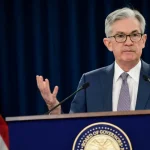

European stock markets face stagnant earnings growth as economic headwinds and high valuations suppress investor returns
Three Key Facts
- UBS projects zero earnings growth for eurozone equities in 2025, significantly below consensus forecasts of 2% growth, with valuations trading at a 5-10% premium to historical averages.
- Selective exposure strategy recommended over broad-based positions, targeting digital infrastructure, defense technology, and globally active European tech companies with lower trade risk exposure.
- Euro Stoxx 50 index target of 5,200 by end-2025, with potential upside to 6,000 if trade deals succeed or downside to 4,000 amid worsening geopolitical tensions.
Introduction
UBS maintains a neutral stance on eurozone equities, signaling caution amid persistent headwinds that threaten near-term growth prospects. The investment bank projects zero earnings growth for the region in 2025, well below market consensus expectations.
This conservative outlook reflects mounting challenges including sluggish economic growth, trade uncertainty, currency pressures, and discontinued ECB rate cuts. The bank’s position represents a significant departure from more optimistic market sentiment, particularly as valuations trade at elevated levels.
Key Developments
UBS identifies multiple risk factors converging to create an uncertain investment environment. According to Investing.com, the bank cites slowing growth momentum, persistent trade tensions, and geopolitical uncertainty as primary concerns.
The firm’s earnings projections show stark divergence from consensus estimates. While UBS forecasts zero growth for 2025 and 5% expansion in 2026, market consensus anticipates 2% and 12% growth respectively for those periods.
Forward price-to-earnings ratios currently sit at 14.3 times, representing a 5-10% premium to historical averages. This valuation premium amplifies downside risks if companies fail to meet earnings targets.
Market Impact
The subdued earnings outlook particularly affects technology companies heavily reliant on European demand. Revenue and profit growth face significant headwinds as economic momentum slows across the region.
UBS sets a Euro Stoxx 50 target of 5,200 by end-2025, rising to 5,600 by mid-2026 under base case assumptions. The bank models scenarios ranging from an upside target of 6,000 with successful policy implementation to a downside of 4,000 amid escalating tensions.
Elevated valuations create additional pressure points for equity performance. The premium pricing leaves little room for disappointment, especially given the challenging earnings environment ahead.
Strategic Insights
UBS advocates for selective exposure rather than broad-based eurozone positioning. The strategy focuses on companies positioned to benefit from structural reforms, fiscal stimulus, and secular trends including digitalization and artificial intelligence.
Key investment themes include beneficiaries of increased European fiscal spending in digital infrastructure and defense technology. The bank also favors globally active European tech companies with reduced exposure to trade risks and small- to mid-cap firms poised for pro-growth reforms.
The approach reflects recognition that government spending on digital transformation, defense, and infrastructure creates targeted opportunities despite broader economic challenges. This selectivity becomes crucial as traditional growth drivers face headwinds.
Expert Opinions and Data
UBS strategists emphasize the importance of timing and selectivity in current market conditions. “We favor selective exposure to the region, and recommend using pullbacks as opportunities to phase into European equities,” the strategists wrote.
The bank maintains cautious optimism about longer-term prospects while acknowledging near-term uncertainty. “It is too early to look that far ahead, given the near-term outlook for growth remains highly uncertain,” UBS analysts caution.
Regarding investment strategy, UBS notes that “by concentrating exposure toward the beneficiaries of these trends, investors can outperform the broader European market.” The firm specifically recommends sectors including IT, industrials, and real estate for potential investment during market pullbacks.
Political and fiscal developments remain critical variables. Germany’s spending plans await autumn approval, while France faces budget and pension reform challenges that could heighten political uncertainty.
Conclusion
UBS’s neutral stance reflects the complex risk-reward dynamics facing eurozone equities. The combination of zero projected earnings growth, elevated valuations, and persistent geopolitical risks justifies a cautious approach to broad market exposure.
The selective investment strategy offers a pathway to navigate current challenges while positioning for eventual recovery. Technology sector opportunities in digital infrastructure, defense, and AI remain compelling despite near-term headwinds affecting the broader European market.








